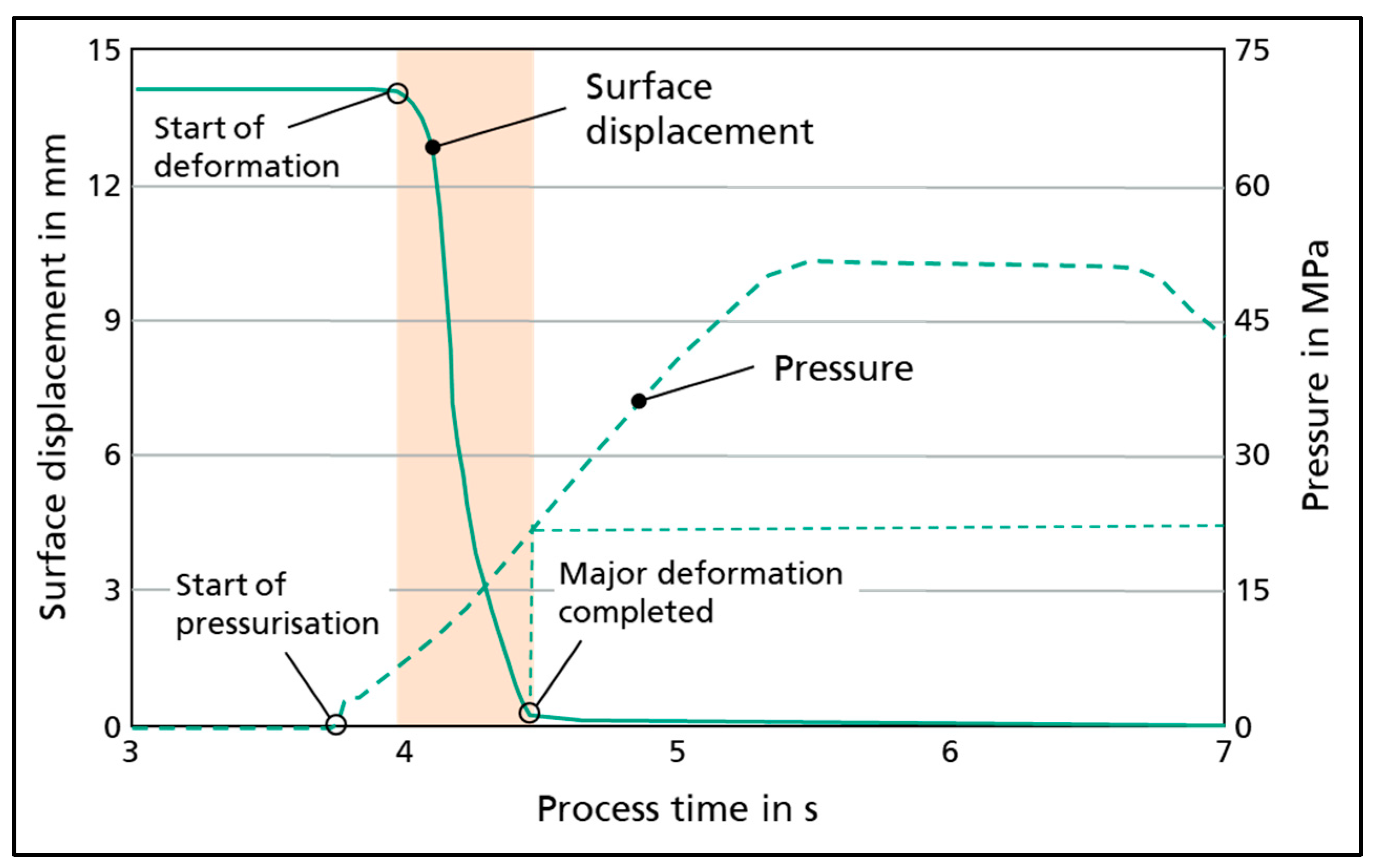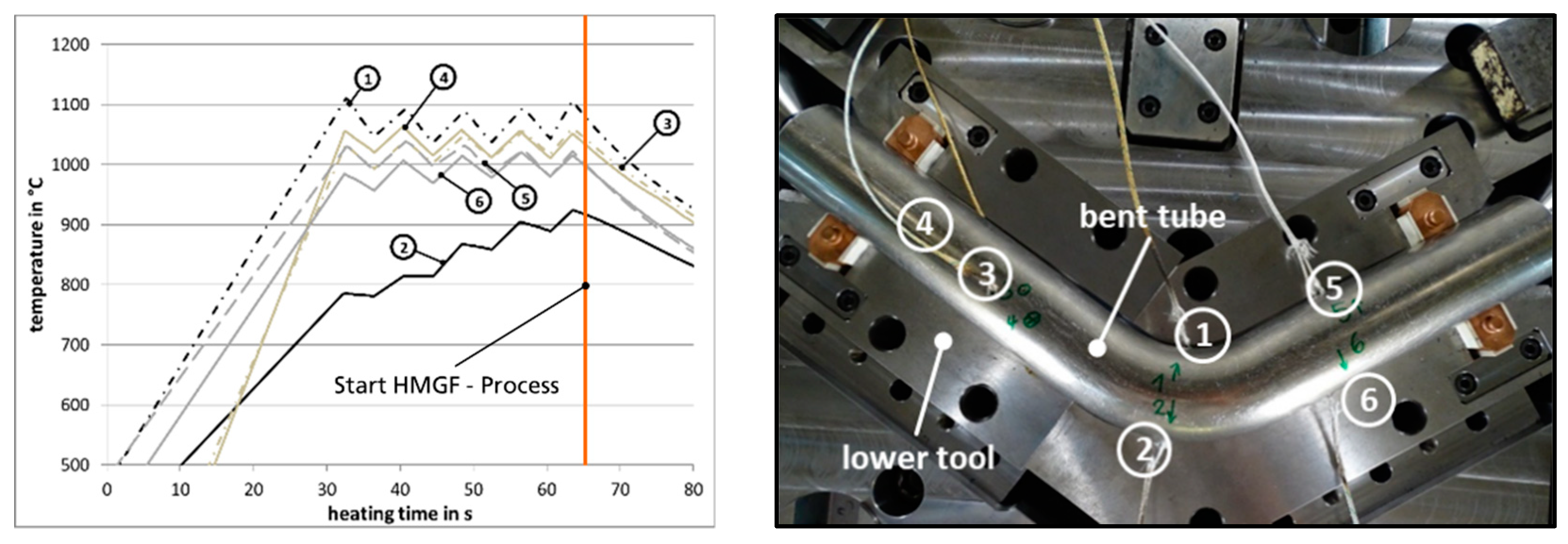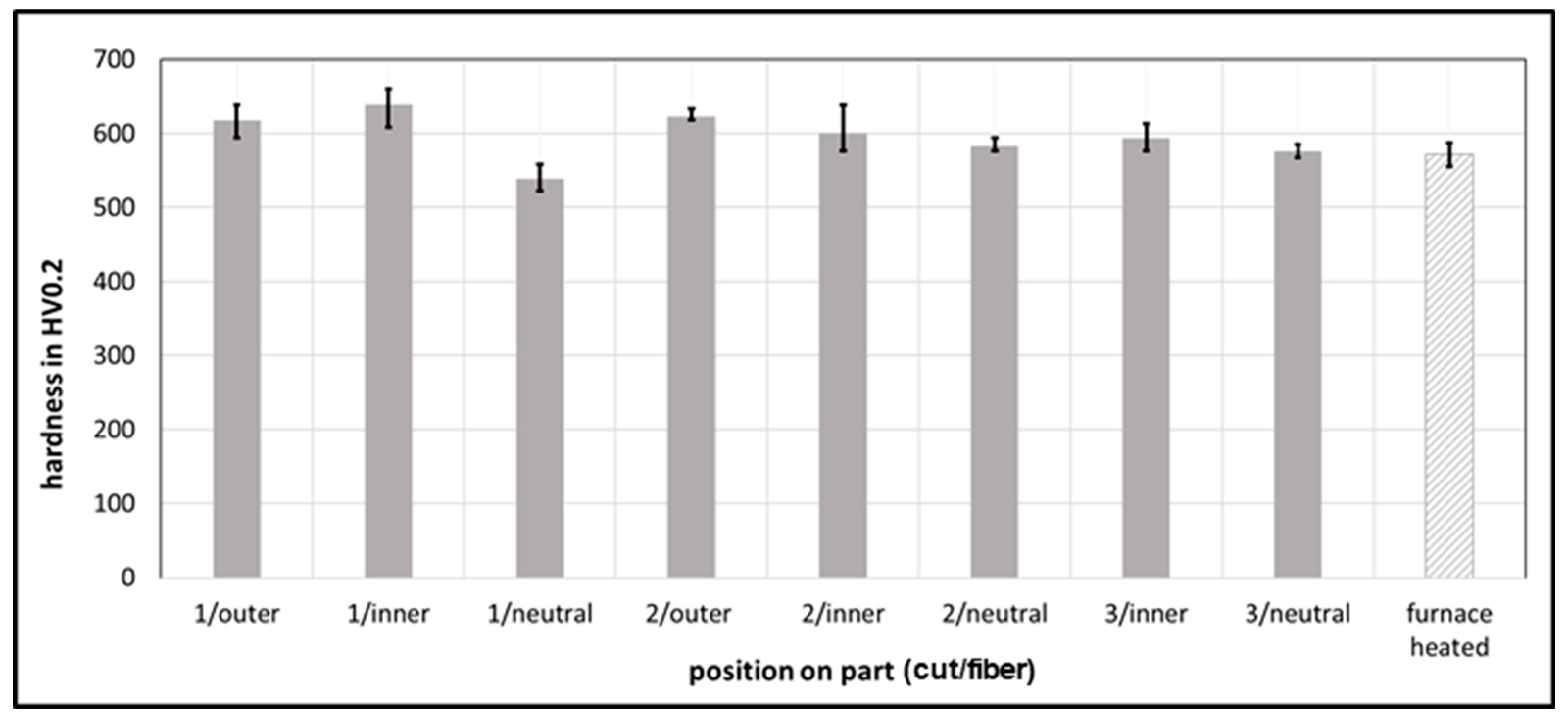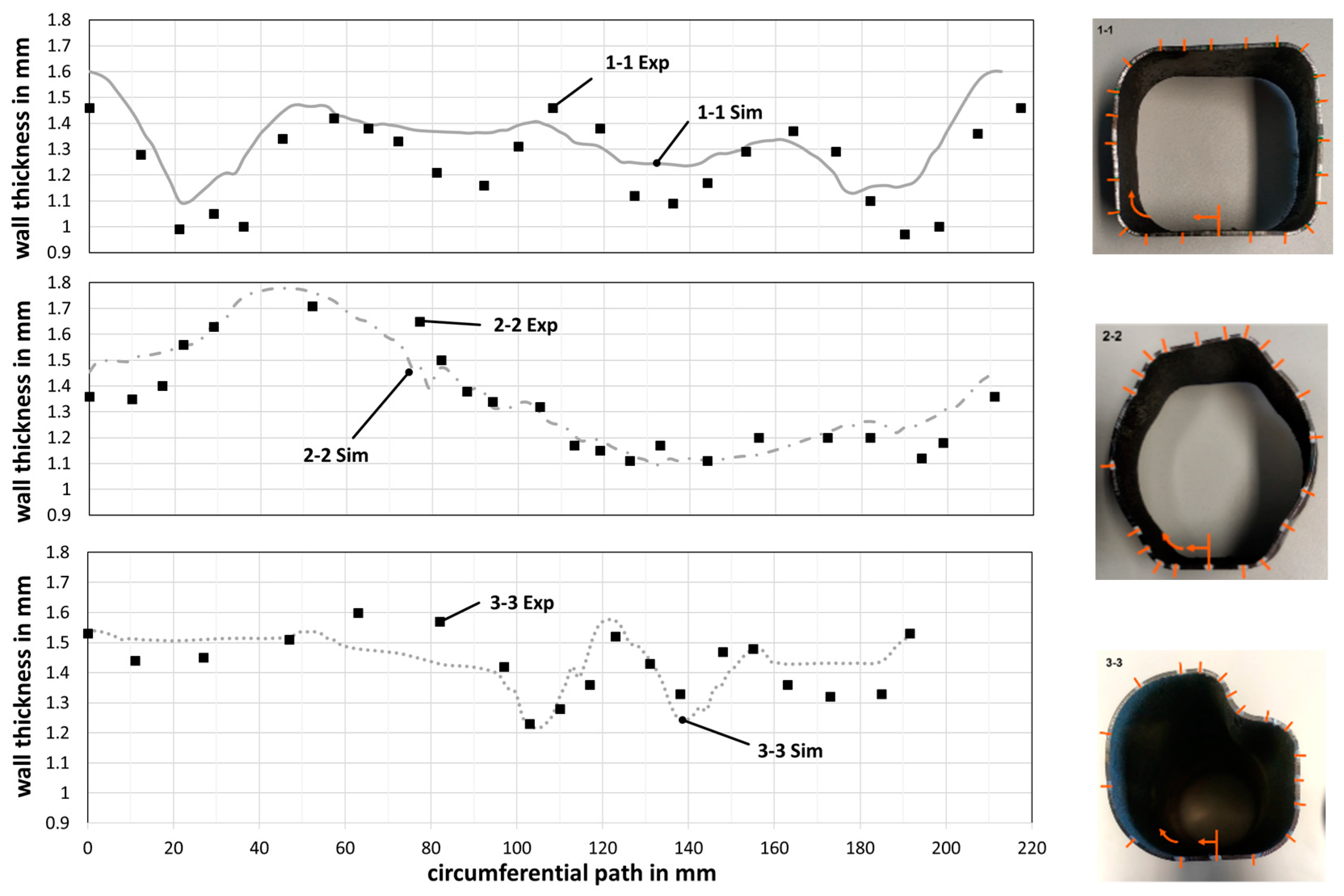Conductive Heating during Press Hardening by Hot Metal Gas Forming for Curved Complex Part Geometries
Abstract
1. Introduction
2. Forming Task
3. Tool Concept and Measurement Technique
- The form elements providing the desired shape of the component with integrated cooling channels that are necessary to prevent accumulated heating of the dies over a number of tests; these elements are highlighted in Figure 4b,
- The electrodes for conduction heating, which are highlighted in Figure 4c,
- Guiding elements and force absorption elements, required for the functionality of the forming process, which are highlighted in Figure 4d,
- Axial punches, sealing the tube and applying the inner gas pressure, see overview in Figure 4a,
- An ejector that prevents the bending area from tilting into the tool engraving, see the green dot in the middle of the tool engraving in Figure 4c.
4. Heating Procedure
5. Forming Tests
6. Characterizing Hardness and Wall Thickness of the Component
7. Summary
Author Contributions
Funding
Conflicts of Interest
References
- Yang, Z. Overview of Global Fuel Economy Policies. In Proceedings of the 2018 APCAP Joint Forumand Clean Air Week Theme: Solutions Landscape for Clean Air, Bangkok, Thailand, 20 March 2018. [Google Scholar]
- Koffler, C. Automobile Produkt-Ökobilanzierung. Ph.D. Thesis, Technische Universtität Darmstadt, Darmstadt, Germany, 2007. [Google Scholar]
- European Commission. Communication from the Commission to the European Parliament, the Council, the European Economic and Social Committee and the Committee of the Regions. 2014. Available online: https://eur-lex.europa.eu/legal-content/EN/TXT/PDF/?uri=CELEX:52014DC0015&from=EN (accessed on 15 July 2020).
- Taub, A.I.; Luo, A.A. Advanced lightweight materials and manufacturing processes for automotive applications. MRS Bull. 2015, 40, 1045–1054. [Google Scholar] [CrossRef]
- Psyk, V.; Kurka, P.; Kimme, S.; Werner, M.; Landgrebe, D.; Ebert, A.; Schwarzendahl, M. Structuring by electromagnetic forming and by forming with an elastomer punch as a tool for component optimisation regarding mechanical stiffness and acoustic performance. Manuf. Rev. 2015, 2, 23. [Google Scholar] [CrossRef]
- Karbasian, H.; Tekkaya, A.E. A review on hot stamping. J. Mater. Process. Technol. 2010, 210, 2103–2118. [Google Scholar] [CrossRef]
- Bell, C.; Corney, J.; Zuelli, N.; Savings, D. A state of the art review of hydroforming technology. Int. J. Mater. Form. 2019, 151, 1–40. [Google Scholar] [CrossRef]
- Paul, A.; Werner, M.; Trân, R.; Landgrebe, D. Hot metal gas forming of titanium grade 2 bent tubes. In AIP Conference Proceedings; AIP Publishing LLC: Melville, NY, USA, 2017; Volume 1896, p. 050009. [Google Scholar]
- Paul, A.; Reuther, F.; Neumann, S.; Albert, A.; Landgrebe, D. Process simulation and experimental validation of Hot Metal Gas Forming with new press hardening steels. J. Phys. Conf. Ser. 2017, 896, 12051. [Google Scholar] [CrossRef]
- Talebi-Anaraki, A.; Chougan, M.; Loh-Mousavi, M.; Maeno, T. Hot Gas Forming of Aluminum Alloy Tubes Using Flame Heating. JMMP 2020, 4, 56. [Google Scholar] [CrossRef]
- Bach, M.; Degenkolb, L.; Reuther, F.; Mauermann, R.; Werner, M. Parameter measurement and conductive heating during press hardening by hot metal gas forming. In Proceedings of the 38th IDDRG Conference Enschede, Enschede, The Netherlands, 3–7 June 2019. [Google Scholar]
- Reuther, F.; Mosel, A.; Freytag, P.; Lambarri, J.; Degenkolb, L.; Werner, M.; Winter, S. Numerical and experimental investigations for hot metal gas forming of stainless steel X2CrTiNb18. Procedia Manuf. 2019, 27, 112–117. [Google Scholar] [CrossRef]
- Maeno, T.; Mori, K.-I.; Unou, C. Improvement of Die Filling by Prevention of Temperature Drop in Gas Forming of Aluminium Alloy Tube Using Air Filled into Sealed Tube and Resistance Heating. Procedia Eng. 2014, 81, 2237–2242. [Google Scholar] [CrossRef][Green Version]
- N.N. Docol PHS 1800 Presshärtender Stahl: Härtbarer Borstahl Für Die Automobilindustrie. Available online: https://www.ssab.de/produkte/warenzeichen/docol/products/docol-phs-1800?accordion=downloads (accessed on 15 July 2020).
- Wu, Y.; Liu, G.; Wang, K.; Liu, Z.; Yuan, S. The deformation and microstructure of Ti-3Al-2.5V tubular component for non-uniform temperature hot gas forming. Int. J. Adv. Manuf. Technol. 2016, 88, 2143–2152. [Google Scholar] [CrossRef]
- Shapiro, B. Using LS-Dyna for Hot Stamping; Dynamore, G.H., Ed.; LSTC: Livermore, CA, USA, 2009. [Google Scholar]
- NANO-X GmbH. AlSi Coat 4001: Product Information. Available online: www.nano-x.de (accessed on 15 July 2020).
- NANO-X GmbH. Verarbeitungsvorschrift X-Tec. Available online: www.nano-x.de (accessed on 15 July 2020).










| C (%) | Si (%) | Mn (%) | P (max%) | S (max%) | Cr (max%) | B (%) |
|---|---|---|---|---|---|---|
| 0.27–0.33 | 0.15–0.35 | 1.00–1.45 | 0.025 | 0.010 | 0.35 | 0.0008–0.0050 |
| Target Temperature | Pulsed Current Amplitude | Heating Time | Maximum Temperature | Pause Time | No. of Cycles | Total Heating Time |
|---|---|---|---|---|---|---|
| 980 °C | 2.500 A | 5 s | 1070 °C | 3 s | 5 | 35 s |
© 2020 by the authors. Licensee MDPI, Basel, Switzerland. This article is an open access article distributed under the terms and conditions of the Creative Commons Attribution (CC BY) license (http://creativecommons.org/licenses/by/4.0/).
Share and Cite
Bach, M.; Degenkolb, L.; Reuther, F.; Psyk, V.; Demuth, R.; Werner, M. Conductive Heating during Press Hardening by Hot Metal Gas Forming for Curved Complex Part Geometries. Metals 2020, 10, 1104. https://doi.org/10.3390/met10081104
Bach M, Degenkolb L, Reuther F, Psyk V, Demuth R, Werner M. Conductive Heating during Press Hardening by Hot Metal Gas Forming for Curved Complex Part Geometries. Metals. 2020; 10(8):1104. https://doi.org/10.3390/met10081104
Chicago/Turabian StyleBach, Mirko, Lars Degenkolb, Franz Reuther, Verena Psyk, Rico Demuth, and Markus Werner. 2020. "Conductive Heating during Press Hardening by Hot Metal Gas Forming for Curved Complex Part Geometries" Metals 10, no. 8: 1104. https://doi.org/10.3390/met10081104
APA StyleBach, M., Degenkolb, L., Reuther, F., Psyk, V., Demuth, R., & Werner, M. (2020). Conductive Heating during Press Hardening by Hot Metal Gas Forming for Curved Complex Part Geometries. Metals, 10(8), 1104. https://doi.org/10.3390/met10081104





